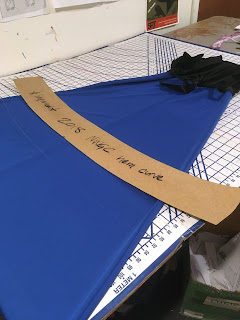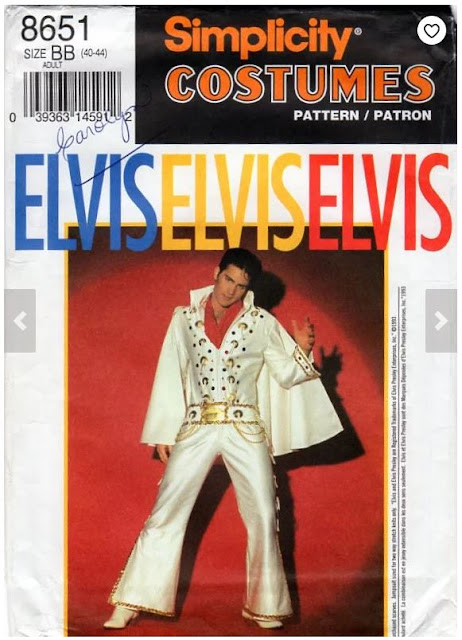I agreed to hem two choirs worth of dresses.
Without seeing what I was hemming.
September, I went in to find out what I had agreed to.
126 dresses. A-line skirt, single layer curved hem.
Double knit.
Two different weights.
Of polyester double knit.
Of polyester double knit.
I haven't sewn double knit anything in about forty-five years.
 |
| Two dress lengths, two marks on two rulers. |
A week of marking hems on wiggly girls.
Then coming home and testing hem treatments.
Did I mention that it's a curved hem?
I'll bet that will be repeated a few times.
This is the largest sewing project I've taken on. To create sanity in the household, I made a schedule, five dresses a day with weekends off. I did some mending, but no other real projects.
If you take anything away from this post, it's this: make a plan and stick to it. Pay it ahead when you can, but make sure you stick to the basic plan and that includes TAKING TIME OFF. You can make Tuesday into your TGI....Tuesday, but build that in there. Treat it like a job and treat yourself like the most valuable employee.
If you take anything away from this post, it's this: make a plan and stick to it. Pay it ahead when you can, but make sure you stick to the basic plan and that includes TAKING TIME OFF. You can make Tuesday into your TGI....Tuesday, but build that in there. Treat it like a job and treat yourself like the most valuable employee.
For you youngsters, poly double knit it is hard to sew without leaving an indentation. There's just so much you can drop the thread tension before it won't make a stitch.
Lots and lots of skipped stitches.
 |
| photo from Plaid Stallions website. Yes, my boyfriend had one of these from the JC Penney store. |
The point of this photo is: you can't see the thread in the topstitching, but your eye is DRAGGED to see the lines that it makes. It's the ditch you stitched. And it's very hard not to make that ditch while you're stitching. Have I bored you with the idea that it's a feature, not a bug? That you can make a virtue out of your mistakes?
That's what an entire era of that 1/4" outline of topstitching is.
I don't want people to see the hem stitching line. I don't want to see it.
That's what an entire era of that 1/4" outline of topstitching is.
I don't want people to see the hem stitching line. I don't want to see it.
Since it's a curved hem, I will need to gather and ease the fabric on the inside, so I will be sewing it from the inside.
The bobbin thread will be the one that shows.
The cover stitch machine or a twin needle is no use to me because of that.
The cover stitch machine or a twin needle is no use to me because of that.
And the stitching is skipping stitches.
I rarely have skipping stitches, and when I do, it feels less like a mechanical problem and more like a demonic possession.
A week of testing out hem finishes, including skipped stitches, different thread weights, needle changes and two different kinds of Class 15 bobbins.
I rarely have skipping stitches, and when I do, it feels less like a mechanical problem and more like a demonic possession.
A week of testing out hem finishes, including skipped stitches, different thread weights, needle changes and two different kinds of Class 15 bobbins.
For the record, the vintage and the recent 15s did not have discernible differences in field testing.
It got resolved.
It got resolved.
I had to try a blind hem. I mean, when you're cutting off over a foot of fabric, you can test out some options. And I do consider a blind hem a proper hem that works well with a large hem allowance. I'd rather a dashed line than a straight ditch.
It would have worked if the hem was straight and I could really let the top and bottom tension out, but neither were possible, and we've gone two variables past the limit of not much room for error.
I tried a couple of other things, but let's move along.
I tried a couple of other things, but let's move along.
I feel like I'm reliving my 70s youth using this stuff. I NEVER USE IT. It's scratchy. It comes in two widths: too wide and too narrow. I have some from the estate sale and Value Village grab bags, but I don't use it.
I used up my entire stash.
I used up my entire stash.
I bought 60 packages of it. I bought out both the local Joanns of the white, silver and beige. Twice.
Much better after being steamed.
See! Not lumpy. Hung out well. Forgot to take photo of that. Too bad.
The black dresses went well enough. I got into a groove and maybe they started taking 50 minutes each, rather than 60.
The blue fabric was a totally different animal.
For one thing, blue is harder to match.
 |
| Upper left seems too dark but it worked |
I've heard you should go darker for topstitching.
At least in this situation, that was correct.
At least in this situation, that was correct.
 |
| Left thread very visible at ten paces. Right, not so much. |
 |
| Lumpy blue hems, some of which got redone. Some did not. After awhile, the metric of "can you see it at ten rows from the back of a galloping horse" sets in. No sir, you cannot, sir. |
They were made to floor length and needed to be hemmed to about 10/11" from the floor.
I was glad I got the choristers to stand so I could put the marking safety pins in the same side seam of the skirt. One less thing to hunt for 126 times.
Laid the dress out flat on the table grid.
I made a new hem curve template, to give me a 4.5" hem. I want to make sure there's enough to play with when they get rehemmed next year. I also want consistency.
Lined it up on the marking pin and verified the other side distance from the waistband.
Doublechecked that it was even, cause I'd really hate to accidentally cut 18 inches off and find out that should have been a different number.
I would like to compliment the manufacturers, as the skirts were uniform length and sewn perfectly on grain. You don't always see that anymore.
Thank you Clover chalk wheel. You did your duty well.
Eased/stretched seam tape onto the black fabric to give it a slight curve (so I wouldn't have to gather it)
Fold over and stitch with a straight stitch.
The blue dresses bubbled at the bottom when I used seam tape, so I sewed them without.
They were wider skirts, to be fair.
They were wider skirts, to be fair.
And they hung better with a zig zag stitch rather than a straight stitch.
That was a day figuring out what the ideal stitch width/length is.
And the skipping returned.
Yes, I sewed over pins from inside
Iron from inside. To be honest, it's more heavy steam and a fabric covered 'clapper'
I also put a muslin cover over the ironing board cover because I wanted to cut down on potential goo and shine accumulation.
Poly gets shiny fast.
I also put a muslin cover over the ironing board cover because I wanted to cut down on potential goo and shine accumulation.
Poly gets shiny fast.
Iron again from outside to settle thread.
 |
| This is grossly overexposed, but to get the thread (the bobbin in this case) to relax into the fabric, I had to iron from the outside as well. |
And repeat.
Every day, for six weeks.
One tag for every dress.
Lots of extra fabric to recycle
 |
| Two of the six bags I ended up with. |
I made sure that I would be able to pull the thread for the hem to move them in the future (the requested hem length is 12 or 11" to the floor, not a proportion of the dress size).
Because - what do we say? Nothing is forever if you have a seam ripper.
I did learn a lot about skipped stitches. Short answer: try every variable. Rethread first (WITH THE PRESSER FOOT UP) but try them all.
Yes, it's boring, but what else are you going to do? Skip the job, dump the project?
Kids, if you get stuck, google search the question you are asking. The Threads boards are full of goodness, like these
http://forums.threadsmagazine.com/gatherings/general-sewing-info/why-do-i-have-skipped-stitches
Neither one of these worked for me (different brand of stretch needle and different thread solved it for me, and by that point I just wanted results, not a thorough study of the topic) but Your Mileage May Vary
I did learn a lot about skipped stitches. Short answer: try every variable. Rethread first (WITH THE PRESSER FOOT UP) but try them all.
Yes, it's boring, but what else are you going to do? Skip the job, dump the project?
Kids, if you get stuck, google search the question you are asking. The Threads boards are full of goodness, like these
http://forums.threadsmagazine.com/gatherings/general-sewing-info/why-do-i-have-skipped-stitches
Neither one of these worked for me (different brand of stretch needle and different thread solved it for me, and by that point I just wanted results, not a thorough study of the topic) but Your Mileage May Vary
Some finishes make it hard for the needle to penetrate properly, or dull the needle quickly, or gum up the needle so it grabs the fabric. Anything that interferes with the smooth flow or rhythm of the mechanism of the machine has the effect of putting it "out of time" and the stitches don't catch. Fabric softener can cause the thread to slip and not catch properly. Too much fabric softener can also gum up the needle. It takes very, very little to become a problem. Rubbing alcohol on a cotton swab will clean your needle.
That being said, sometimes, a spray starch can sometimes solve a tricky stitching problem in very fine or slippy fabrics. ALWAYS test stitch scraps FIRST. -
by
threadkoe
http://forums.threadsmagazine.com/members/threadkoe
You see, when the needle pierces the fabric, on it's way back up it has to make a loop at the "scarf" of the needle. (The scarf is the "shaved out" place on the back of the needle just above the eye of the needle. If the needle you are using is too small, the loop will not be made on the way back up and then the bobbin "hook" cannot catch it - the fabric is holding the upper spool thread to tight against the needle.
by Ms Flair
http://forums.threadsmagazine.com/user/16281
Thanks for making it through this post. I could break it up into smaller posts, but I just want to be done.
I'm so done. Done di done done done.








































































